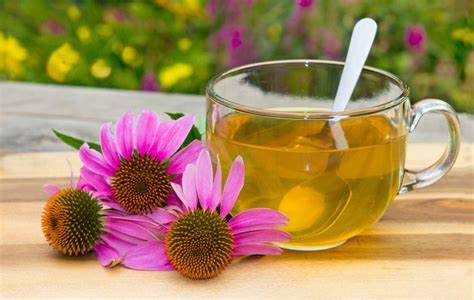Can a simple plant improve your immune system against daily sicknesses? Echinacea is a Native American medicine that claims it can. Even though experts still argue, many prefer this natural booster.

Echinacea has been around for many years in teas, pills, and droplets. It started in Native American traditions and moved into our everyday health plan. It’s liked in the United States, being among the top 10 plant supplements. But, does its power in labs really help people?
Studies show echinacea may not cut colds short or stop them. Yet, it is used a lot for its potential to help the immune system. So, many still use it hoping it will strengthen their defences.
Key Takeaways
- Echinacea is praised for its potential immune-boosting properties.
- It is widely consumed in the form of teas, supplements, and tinctures.
- Originating from Native American medicinal practices, echinacea has a long history of use.
- Its active constituents are believed to aid in inflammation and immune response.
- Scientific evidence remains conflicted over its efficacy in preventing or treating the common cold.
- Echinacea remains one of the top 10 herbal supplements in the United States.
The History and Origin of Echinacea
The herb echinacea has deep roots in Native American medicine. They used it for snake bites, sore throats, and more. They knew of its healing powers long before Europeans arrived in America.
Native American Usage
Echinacea wasn’t the only helpful plant in Native American culture. But, it was used widely for healing. They used it in many ways, like in teas or by putting it on their skin. This shows how important echinacea was for them.
Introduction to Europe
In the 18th century, European settlers learned about echinacea. They were impressed by the stories of its benefits. So, they started using it too. This started European herbal adoption of echinacea. It shows how knowledge of healing plants travels across the world.
What is Echinacea?
Echinacea, also known as the coneflower, is part of the daisy family. It is famous for its potential health benefits. This powerful herb includes different species and varieties.

Different Varieties of Echinacea
There are three key Echinacea varieties for herbal medicine: Echinacea purpurea, E. angustifolia, and E. pallida. These types are often used to support the immune system. Their use, however, makes it hard to create exact standards because of their complexity.
Main Components of Echinacea
Echinacea gets its healing power from various active parts. Compounds like caffeic acid and alkamides are vital for its effect. These elements give Echinacea its medicinal value, especially for boosting the immune system.
How Echinacea Affects the Immune System
Echinacea can help our immune system work better. Lab tests on this herb are positive. They show it boosts white blood cells and some key proteins that fight off infections.
Lab Studies vs. Human Trials
In labs and on animals, echinacea looks great. But, testing on people gives mixed results. It’s hard to say for sure if it helps fight infections in humans.
White Blood Cell Stimulation
In labs, echinacea is proven to increase white blood cell activity. This suggests it could help our immune system. But, translating this to real human benefits is still uncertain. Human studies don’t always show the same positive effects.
Echinacea and Common Cold Prevention
Echinacea has always been a top pick for dealing with common colds. Yet, it’s key to look into recent studies on how good it is at stopping the common cold.
Research Findings
Recent research gives mixed results on echinacea’s cold-stopping power. Some studies show it doesn’t beat a sugar pill at making colds less likely or shorter. This means the debate on whether echinacea actually helps with the common cold is ongoing.
Practical Advice
Since the science on echinacea is up in the air, experts suggest other actions to avoid getting sick. They recommend keeping your hands clean, not touching your face a lot, and making sure you sleep well. These are more certain ways to stay cold-free than relying only on echinacea.

Echinacea Dosage Recommendations
Echinacea comes in many forms, making it hard to pin down the right dose. It’s important to know about the types and how much to use. This info lets you choose wisely.
Common Forms of Echinacea
Echinacea can be found as powders, teas, and more. Each kind has its perks, like teas are calming. Tinctures give stronger amounts.
General Dosage Guidelines
No set rules for echinacea intake guidelines exist. But, experts often advise using it short-term. For example, 300-500 mg of dry extract or 2.5 ml of liquid extract three times a day.
Sticking to these doses could help avoid side effects. Yet, it’s wise to check the instructions on the product and talk to a doctor first.
Potential Side Effects of Echinacea
Echinacea is safe for many people, but it can cause side effects. Some people might get an upset stomach or a rash. These reactions are usually not serious. However, in rare cases, some could have a very bad allergic reaction.

If you have a disorder where your immune system attacks itself or take drugs that weaken your immune system, echinacea may not be safe for you. It could change how your immune system works. So, it’s smart to talk to a doctor before using it to make sure it won’t cause harm. This advice is extra important for pregnant women and those allergic to plants like chrysanthemums or ragweed. They could have a bad reaction.
Knowing about herbal remedy contraindications is crucial to avoid problems when using echinacea. Talk about your medications and health problems to stop side effects before they happen.
Antioxidant Properties of Echinacea
Echinacea has high levels of antioxidants. These include caffeic acid, flavonoids, cichoric acid, and alkamides. These compounds help fight oxidative stress which can lead to chronic diseases. They work by stopping free radicals, boosting health.
Research shows echinacea does more than boost immunity. It’s very effective in fighting off harmful elements in the body. This is especially true for extracts from the plant’s flowers and roots. These extracts help protect cells, supporting the body against diseases.
Anti-inflammatory Benefits
Echinacea is famous for its anti-inflammatory benefits. Studies in animals and people support this. They show it can reduce inflammation. This makes it very useful for treating different conditions. For example, it helps with osteoarthritis.
Its influence on how the immune system reacts to inflammation is also big. It affects important immune cells. These include macrophages and natural killer cells. They’re vital in the body’s fight against inflammation. Echinacea seems to help them work better. This points to echinacea having a wide therapeutic effect against inflammation. This means it can help deal with inflammatory issues.

Echinacea isn’t just good for easing symptoms. It also boosts well-being. As we learn more, we see just how far-reaching echinacea’s potential is. It’s becoming a key part of natural health care.
Echinacea’s Role in Skin Health
Echinacea is now known for improving skin conditions and making skin look younger. It’s getting more popular for herbal skin treatment. This provides a natural choice against artificial skin products.
Improving Skin Conditions
Echinacea shows promise in helping with skin problems like eczema. It has properties that calm skin and fight skin ageing. Yet, its benefit in skin products may be short-lived because it can expire quickly.
Products That Include Echinacea
Skincare items like creams and serums now use echinacea because of its good effects on the skin. But, the amount of echinacea and the product’s expiry date are key things to check. Even with these issues, the interest in adding echinacea to beauty products is increasing.

